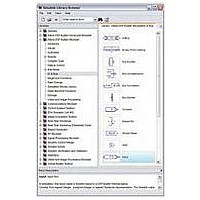IPT-DSPBUILDER Altera, IPT-DSPBUILDER Datasheet - Page 89

IPT-DSPBUILDER
Manufacturer Part Number
IPT-DSPBUILDER
Description
DSP BUILDER SOFTWARE
Manufacturer
Altera
Type
DSPr
Datasheet
1.IPT-DSPBUILDER.pdf
(422 pages)
Specifications of IPT-DSPBUILDER
Function
DSP Builder
License
Initial License
Software Application
IP CORE, DSP BUILDER
Core Architecture
FPGA
Core Sub-architecture
Arria, Cyclone, Stratix
Supported Families
Arria GX, Arria II GX, Cyclone, Stratix
Rohs Compliant
NA
Lead Free Status / RoHS Status
Not applicable / Not applicable
- Current page: 89 of 422
- Download datasheet (6Mb)
HIL Design Flow
© June 2010 Altera Corporation
Adding the HIL block to your Simulink model allows you to cosimulate a Quartus II
software design with a physical FPGA board implementing a portion of that design.
You define the contents and function of the FPGA by creating and compiling a
Quartus II project. A simple JTAG interface between Simulink and the FPGA board
links the two.
The main benefits of using the HIL block are faster simulation and richer
instrumentation. The Quartus II project you embed in an FPGA runs faster than a
software-only simulation. To further increase simulation speed, the HIL block offers
frame and burst modes of data transfer that are significantly faster than single-step
mode when you use it with suitable designs.
The HIL block also makes available to the hardware a large Simulink library of sinks
and sources, such as channel models and spectrum analyzers, which can give you
greater control and observability.
This chapter explains the HIL block design flow, walks through an example using the
HIL block, and discusses the optional burst and frame data transfer modes.
The HIL block in AltLab library of the Altera DSP Builder Blockset enables the HIL
functionality. It represents the functions implemented on your FPGA, and works
smoothly with the normal DSP Builder/Simulink work flow.
The HIL design flow comprises the following steps:
1. Create a Quartus II project that defines the functions you want to co-simulate in
2. Add the HIL block to your Simulink model and import the compiled Quartus II
3. Specify parameters for the HIL block, including the following options:
4. Compile the HIL block to create a programming object file (.pof) for hardware
hardware and use Signal Compiler block to compile the Quartus II project
through the Quartus II Fitter.
project into the HIL block. You can also connect instrumentation to your HIL block
by adding additional blocks from the Simulink Sinks and Sources libraries.
1
■
■
■
■
■
cosimulation.
The Quartus II project to define its functionality
The clock and reset pins
The reset active level
The input and output pin characteristics
The use of single-step versus burst and frame mode
If the original design contains a Clock block that defines a period and
sample time that is different from the default values, you must add a Clock
block with the same values as the HIL block.
Preliminary
DSP Builder Standard Blockset User Guide
5. Using HIL
Related parts for IPT-DSPBUILDER
Image
Part Number
Description
Manufacturer
Datasheet
Request
R

Part Number:
Description:
CYCLONE II STARTER KIT EP2C20N
Manufacturer:
Altera
Datasheet:

Part Number:
Description:
CPLD, EP610 Family, ECMOS Process, 300 Gates, 16 Macro Cells, 16 Reg., 16 User I/Os, 5V Supply, 35 Speed Grade, 24DIP
Manufacturer:
Altera Corporation
Datasheet:

Part Number:
Description:
CPLD, EP610 Family, ECMOS Process, 300 Gates, 16 Macro Cells, 16 Reg., 16 User I/Os, 5V Supply, 15 Speed Grade, 24DIP
Manufacturer:
Altera Corporation
Datasheet:

Part Number:
Description:
Manufacturer:
Altera Corporation
Datasheet:

Part Number:
Description:
CPLD, EP610 Family, ECMOS Process, 300 Gates, 16 Macro Cells, 16 Reg., 16 User I/Os, 5V Supply, 30 Speed Grade, 24DIP
Manufacturer:
Altera Corporation
Datasheet:

Part Number:
Description:
High-performance, low-power erasable programmable logic devices with 8 macrocells, 10ns
Manufacturer:
Altera Corporation
Datasheet:

Part Number:
Description:
High-performance, low-power erasable programmable logic devices with 8 macrocells, 7ns
Manufacturer:
Altera Corporation
Datasheet:

Part Number:
Description:
Classic EPLD
Manufacturer:
Altera Corporation
Datasheet:

Part Number:
Description:
High-performance, low-power erasable programmable logic devices with 8 macrocells, 10ns
Manufacturer:
Altera Corporation
Datasheet:

Part Number:
Description:
Manufacturer:
Altera Corporation
Datasheet:

Part Number:
Description:
Manufacturer:
Altera Corporation
Datasheet:

Part Number:
Description:
Manufacturer:
Altera Corporation
Datasheet:

Part Number:
Description:
CPLD, EP610 Family, ECMOS Process, 300 Gates, 16 Macro Cells, 16 Reg., 16 User I/Os, 5V Supply, 25 Speed Grade, 24DIP
Manufacturer:
Altera Corporation
Datasheet:











